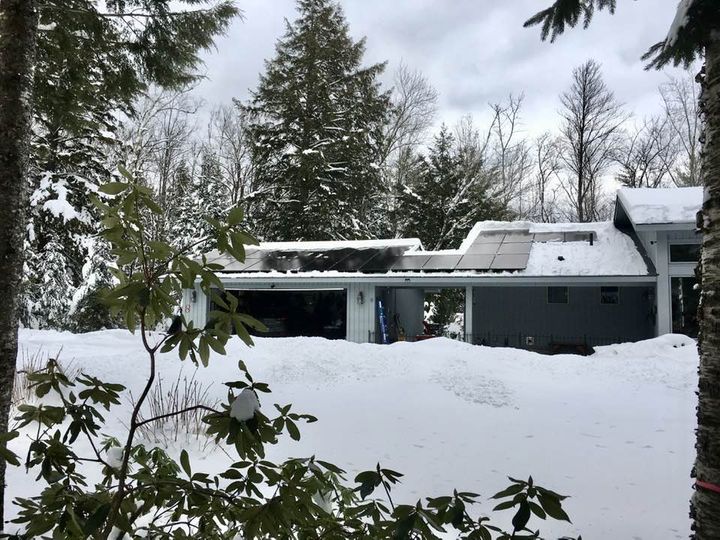Proton Farming in New Hampshire
With some of the highest electricity rates in the country it makes sense to have a solar array in New Hampshire if one has a suitable site. The solar panel have become more efficient and less costly. Plus tax incentives in the IRA Act provide a 30% savings. One can save money and reduce their carbon footprint. The payback period in New Hampshire is around 10 years and after that you are basically getting free electricity.
We had a 27-panel solar array installed on the garage and breezeway by Granite State Solar. Each panel is rated at 400 watts with Enphase IQ8 microinverters and a Tesla Powerwall II for battery storage.
The Tesla Powerwall II provides an effective 10.5 kWh of storage for power outages and stores excess power generated during the day for night usage. Without this storage excess electricity would go back to the grid for credits but the utility discounts these credits so it’s best to use the electricity when it is produced or store it onsite for later use.
Our location is what it is – In New Hampshire subjected to clouds, snow, ice etc. The pitch is flatter than ideal, the orientation is less than ideal (Southwest) and we have trees around. That said we do manage to get some 100%+ solar-powered days and send some excess back to the grid via a Net Meter during the longer, sunnier days of spring summer and fall.
Since having our solar array installed Mid-Sept 2022, here are monthly production numbers for clean solar electricity:
- Sept 2022 (two weeks) – 573 kWh
- Oct 2022 – 534 kWh
- Nov 2022 – 293 kWh
- Dec 2022 – 138 kWh
- Jan 2023 – 178 kWh
- Feb 2023 – kWh
Here is the average solar production numbers for New Hampshire in ideal situations. These numbers are potential or ideal. Of course, any of the following factors will bring down one’s actual results to varying degrees:
- Snow
- Rain
- Clouds
- Shadows (trees, roof, chimney etc)
- Dust
- Bird poop
- Panel orientation
- Panel tilt angle
In our particular situation with our orientation and tilt angle as well as trees nearby, I predict our array will underperform in the winter months and then over-perform in the summer months.
| Month | Solar radiation per day | Solar radiation per month | Solar energy per month 1 panel | Solar energy per month 20 panels |
| January | 2.97 kWh/m² | 92.07 kWh/m² | 20.72 kWh | 414.32 kWh |
| February | 4.00 kWh/m² | 112.00 kWh/m² | 25.20 kWh | 504.00 kWh |
| March | 4.62 kWh/m² | 143.22 kWh/m² | 32.22 kWh | 644.49 kWh |
| April | 5.46 kWh/m² | 163.80 kWh/m² | 36.86 kWh | 737.10 kWh |
| May | 5.71 kWh/m² | 177.01 kWh/m² | 39.83 kWh | 796.55 kWh |
| June | 5.86 kWh/m² | 175.80 kWh/m² | 39.56 kWh | 791.10 kWh |
| July | 6.24 kWh/m² | 193.44 kWh/m² | 43.52 kWh | 870.48 kWh |
| August | 5.96 kWh/m² | 184.76 kWh/m² | 41.57 kWh | 831.42 kWh |
| September | 5.08 kWh/m² | 152.40 kWh/m² | 34.29 kWh | 685.80 kWh |
| October | 3.70 kWh/m² | 114.70 kWh/m² | 25.81 kWh | 516.15 kWh |
| November | 2.95 kWh/m² | 88.50 kWh/m² | 19.91 kWh | 398.25 kWh |
| December | 2.54 kWh/m² | 78.74 kWh/m² | 17.72 kWh | 354.33 kWh |
As of February 2023, the average solar panel cost in New Hampshire is $3.59/W. Given a solar panel system size of 5 kilowatts (kW), an average solar installation in New Hampshire ranges in cost from $15,258 to $20,642, with the average gross price for solar in New Hampshire coming in at $17,950. – Jan 5, 2023
Compare the costs of a family vacation – a family of four, the average cost of vacation will be between $4,100 and $5,100 – and at the end of the vacation you are left with photos and memories (priceless of course). But solar is the gift that keeps on giving. Money spent on a family vacation is gone forever. Money spent on solar pays for itself in 10 years and after that, it pays you. Think of it as a long-term investment that pays dividends for 15 years or more.
